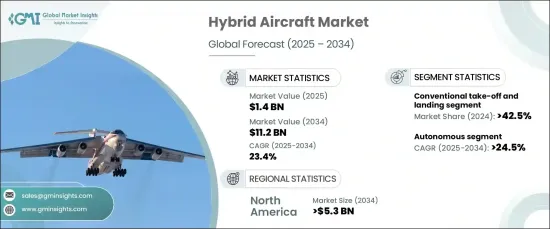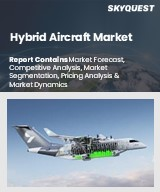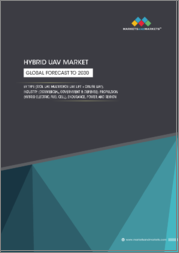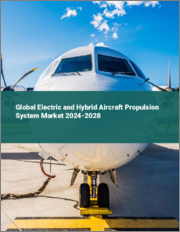
|
시장보고서
상품코드
1665280
하이브리드 항공기 시장 : 시장 기회, 성장 촉진요인, 산업 동향 분석, 예측(2025-2034년)Hybrid Aircraft Market Opportunity, Growth Drivers, Industry Trend Analysis, and Forecast 2025 - 2034 |
||||||
세계의 하이브리드 항공기 시장은 2034년까지 14억 달러에 이를 전망이며, 2025년부터 2034년까지 CAGR은 23.4%라는 경이적인 성장을 이룰 것으로 예측되고 있습니다. 이러한 현저한 성장은 산업과 정부가 이산화탄소 배출량을 줄이고 연료 효율을 개선하는 것을 선호하는 가운데, 보다 지속가능한 항공 솔루션에 대한 수요가 증가하고 있다는 것이 배경입니다.

전기 추진 시스템과 에너지 저장 시스템의 기술적 진보는 하이브리드 항공기의 미래를 형성하는데 있어서 매우 중요한 역할을 합니다. 이러한 하이브리드 전기 추진 시스템은 이산화탄소 배출량을 줄이고 연료 효율을 높임으로써 항공이 환경에 미치는 영향을 줄이도록 설계되었습니다. 각 제조업체는 이러한 시스템을 지역 및 단거리 노선 항공기에 통합하는 움직임을 강화하고 있으며 향후 배터리 기술 개선에 따라 장거리 노선 항공기에 적용될 가능성도 있습니다.
| 시장 범위 | |
|---|---|
| 시작 연도 | 2024년 |
| 예측 연도 | 2025-2034년 |
| 시작 금액 | 14억 달러 |
| 예측 금액 | 112억 달러 |
| CAGR | 23.4% |
시장은 기존 이착륙기(CTOL), 단거리 이착륙기(STOL), 수직 이착륙기(VTOL) 등 양력 기술에 따라 다양한 범주로 나뉩니다. 2024년에는 CTOL 부문이 42.5%로 가장 큰 점유율을 차지했으며, 앞으로도 강력한 페이스로 성장할 것으로 예상됩니다. 하이브리드 CTOL 항공기는 활주로 및 정비 시설과 같은 기존 항공 인프라를 이용할 수 있기 때문에 특히 매력적이며 미래의 항공 산업에 실용적이고 지속 가능한 옵션이 되었습니다.
시장은 또한 조종 모드에 따라 조종 항공기와 자율 항공기로 구분됩니다. 자율 부문은 급성장하고 2034년 CAGR은 24.5%로 예측됩니다. 인공지능, 센서 기술, 비행 자동화 시스템의 획기적인 진보로 항공기는 인간의 개입 없이 단독으로 작동하여 장애물을 피하고 필수적인 시스템 점검을 수행할 수 있게 되었습니다. 이는 특히 화물 운송, 모니터링 및 재해 대응과 같은 부문에서 무인 항공기가 비용 효율적이고 신뢰할 수 있는 솔루션을 제공함으로써 안전성과 효율성을 향상시킵니다.
북미는 현재 하이브리드 항공기 시장에서 지배적인 지역으로 앞으로도 계속 성장하고 있으며 2034년에는 시장 규모가 53억 달러에 달할 것으로 예상됩니다. 미국은 하이브리드 항공기 개발의 최전선에 있으며 지속 가능한 항공 솔루션에 중점을 둡니다. 대기업 우주 기업은 신흥 신흥 기업과 함께 전기 및 하이브리드 전기 추진 기술에 많은 투자를 하고 있으며 주로 지역 및 단거리 하이브리드 항공기에 초점을 맞추었습니다. 이러한 솔루션은 연료 효율과 배출량 감소 측면에서 큰 이점을 제공하고 시장을 견인하고 있습니다.
목차
제1장 조사 방법 및 조사 범위
- 시장 범위 및 정의
- 기본 추정 및 계산
- 예측 계산
- 데이터 소스
- 1차 데이터
- 2차 자료
- 유료 정보원
- 공적 정보원
제2장 주요 요약
제3장 산업 인사이트
- 생태계 분석
- 밸류체인에 영향을 주는 요인
- 이익률 분석
- 변혁
- 장래 전망
- 제조업체
- 유통업체
- 공급자의 상황
- 이익률 분석
- 주요 뉴스
- 규제 상황
- 영향 요인
- 성장 촉진요인
- 친환경 항공 솔루션에 대한 수요 증가
- 전동 수직 이착륙(eVTOL) 솔루션의 성장
- 효율적인 하이브리드 엔진 개발에 주목 증가
- 하이브리드 전기 추진을 위한 에너지 저장 및 효율 개선에 대한 수요 증가
- 하이브리드 항공기 연구를 위한 관민으로부터의 자금 제공 증가
- 산업의 잠재적 리스크 및 과제
- 높은 개발 비용
- 배터리의 한계
- 성장 촉진요인
- 성장 가능성 분석
- Porter's Five Forces 분석
- PESTEL 분석
제4장 경쟁 구도
- 서문
- 기업 점유율 분석
- 경쟁 포지셔닝 매트릭스
- 전략 전망 매트릭스
제5장 시장 추정 및 예측 : 항공기 유형별(2021-2034년)
- 주요 동향
- 지역 수송기
- 비즈니스 제트기
- 소형 및 초경량 항공기
- 무인 항공기
- 선진 항공 모빌리티
제6장 시장 추정 및 예측 : 양력 기술별(2021-2034년)
- 주요 동향
- 기존 이착륙기(CTOL)
- 단거리 이착륙기(STOL)
- 수직 이착륙기(VTOL)
제7장 시장 추정 및 예측 : 연료 유형별(2021-2034년)
- 주요 동향
- 연료 하이브리드
- 수소 하이브리드
제8장 시장 추정 및 예측 : 항속 거리별(2021-2034년)
- 주요 동향
- 100km 이하
- 101-500 km
- 501km 이상
제9장 시장 추정 및 예측 : 조종 모드별(2021-2034년)
- 주요 동향
- 조종형
- 자율형
제10장 시장 추정 및 예측 : 지역별(2021-2034년)
- 주요 동향
- 북미
- 미국
- 캐나다
- 유럽
- 영국
- 독일
- 프랑스
- 이탈리아
- 스페인
- 러시아
- 아시아태평양
- 중국
- 인도
- 일본
- 한국
- 호주
- 라틴아메리카
- 브라질
- 멕시코
- 중동 및 아프리카
- 남아프리카
- 사우디아라비아
- 아랍에미리트(UAE)
제11장 기업 프로파일
- Airbus
- Ampaire
- Electric Aviation Group
- Embraer
- Faradair Aerospace
- General Electric
- Heart Aerospace
- Pipistrel
- RTX
- Safran
- Voltaero
- XTI Aircraft
The Global Hybrid Aircraft Market is projected to reach USD 1.4 billion by 2034, growing at an impressive CAGR of 23.4% from 2025 to 2034. This significant growth is being driven by the increasing demand for more sustainable aviation solutions as industries and governments prioritize reducing carbon emissions and improving fuel efficiency.

Technological advancements in electric propulsion and energy storage systems are playing a pivotal role in shaping the future of hybrid aircraft. These hybrid-electric propulsion systems are designed to reduce the environmental impact of aviation by lowering carbon emissions and boosting fuel efficiency. Manufacturers are increasingly integrating these systems into regional and short-haul aircraft, with the potential for long-haul applications depending on future improvements in battery technology.
| Market Scope | |
|---|---|
| Start Year | 2024 |
| Forecast Year | 2025-2034 |
| Start Value | $1.4 Billion |
| Forecast Value | $11.2 Billion |
| CAGR | 23.4% |
The market is divided into different categories based on lift technology, including conventional take-off and landing (CTOL), short take-off and landing (STOL), and vertical take-off and landing (VTOL) aircraft. In 2024, the CTOL segment held the largest share of the market at 42.5%, and it is expected to continue growing at a strong pace. Hybrid CTOL aircraft are particularly attractive because they can utilize existing aviation infrastructure, such as runways and maintenance facilities, making them a practical and sustainable choice for the future of aviation.
The market is also segmented based on the mode of operation into piloted and autonomous aircraft. The autonomous segment is set to experience rapid growth, with a projected CAGR of 24.5% through 2034. Breakthroughs in artificial intelligence, sensor technologies, and flight automation systems are enabling aircraft to operate independently, avoid obstacles, and perform essential system checks without human intervention. This is leading to greater safety and efficiency, particularly in sectors such as cargo transport, surveillance, and disaster response, where unmanned aircraft offer cost-effective and reliable solutions.
North America is currently the dominant region in the hybrid aircraft market and is expected to continue its growth, reaching a market value of USD 5.3 billion by 2034. The United States is at the forefront of hybrid aircraft development, with a strong emphasis on sustainable aviation solutions. Major aerospace companies, alongside emerging startups, are heavily investing in electric and hybrid-electric propulsion technologies, focusing primarily on regional and short-haul hybrid aircraft. These solutions offer significant advantages in terms of fuel efficiency and reduced emissions, driving the market forward.
Table of Contents
Chapter 1 Methodology & Scope
- 1.1 Market scope & definitions
- 1.2 Base estimates & calculations
- 1.3 Forecast calculations
- 1.4 Data sources
- 1.4.1 Primary
- 1.4.2 Secondary
- 1.4.2.1 Paid sources
- 1.4.2.2 Public sources
Chapter 2 Executive Summary
- 2.1 Industry synopsis, 2021-2034
Chapter 3 Industry Insights
- 3.1 Industry ecosystem analysis
- 3.1.1 Factor affecting the value chain
- 3.1.2 Profit margin analysis
- 3.1.3 Disruptions
- 3.1.4 Future outlook
- 3.1.5 Manufacturers
- 3.1.6 Distributors
- 3.2 Supplier landscape
- 3.3 Profit margin analysis
- 3.4 Key news & initiatives
- 3.5 Regulatory landscape
- 3.6 Impact forces
- 3.6.1 Growth drivers
- 3.6.1.1 Increasing demand for eco-friendly aviation solutions
- 3.6.1.2 Growth in electric vertical takeoff and landing (eVTOL) solutions
- 3.6.1.3 Rising focus on the development of efficient hybrid engines
- 3.6.1.4 Increasing demand for improved energy storage and efficiency for hybrid-electric propulsion.
- 3.6.1.5 Growing funding from public and private sectors for hybrid aircraft research
- 3.6.2 Industry pitfalls & challenges
- 3.6.2.1 High development costs
- 3.6.2.2 Battery limitations
- 3.6.1 Growth drivers
- 3.7 Growth potential analysis
- 3.8 Porter’s analysis
- 3.9 PESTEL analysis
Chapter 4 Competitive Landscape, 2024
- 4.1 Introduction
- 4.2 Company market share analysis
- 4.3 Competitive positioning matrix
- 4.4 Strategic outlook matrix
Chapter 5 Market Estimates & Forecast, By Aircraft Type, 2021-2034 (USD Million & Units)
- 5.1 Key trends
- 5.2 Regional transport aircraft
- 5.3 Business jets
- 5.4 Light and ultralight aircraft
- 5.5 Unmanned aerial vehicles
- 5.6 Advanced air mobility
Chapter 6 Market Estimates & Forecast, By Lift Technology, 2021-2034 (USD Million & Units)
- 6.1 Key trends
- 6.2 Conventional Take-off and landing
- 6.3 Short Take-off and landing
- 6.4 Vertical Take-off and landing
Chapter 7 Market Estimates & Forecast, By Fuel Type, 2021-2034 (USD Million & Units)
- 7.1 Key trends
- 7.2 Fuel hybrid
- 7.3 Hydrogen hybrid
Chapter 8 Market Estimates & Forecast, By Range, 2021-2034 (USD Million & Units)
- 8.1 Key trends
- 8.2 < 100 km
- 8.3 101 km to 500 km
- 8.4 > 501 km
Chapter 9 Market Estimates & Forecast, By Mode of Operation 2021-2034 (USD Million & Units)
- 9.1 Key trends
- 9.2 Piloted
- 9.3 Autonomous
Chapter 10 Market Estimates & Forecast, By Region, 2021-2034 (USD Million & Units)
- 10.1 Key trends
- 10.2 North America
- 10.2.1 U.S.
- 10.2.2 Canada
- 10.3 Europe
- 10.3.1 UK
- 10.3.2 Germany
- 10.3.3 France
- 10.3.4 Italy
- 10.3.5 Spain
- 10.3.6 Russia
- 10.4 Asia Pacific
- 10.4.1 China
- 10.4.2 India
- 10.4.3 Japan
- 10.4.4 South Korea
- 10.4.5 Australia
- 10.5 Latin America
- 10.5.1 Brazil
- 10.5.2 Mexico
- 10.6 MEA
- 10.6.1 South Africa
- 10.6.2 Saudi Arabia
- 10.6.3 UAE
Chapter 11 Company Profiles
- 11.1 Airbus
- 11.2 Ampaire
- 11.3 Electric Aviation Group
- 11.4 Embraer
- 11.5 Faradair Aerospace
- 11.6 General Electric
- 11.7 Heart Aerospace
- 11.8 Pipistrel
- 11.9 RTX
- 11.10 Safran
- 11.11 Voltaero
- 11.12 XTI Aircraft
















